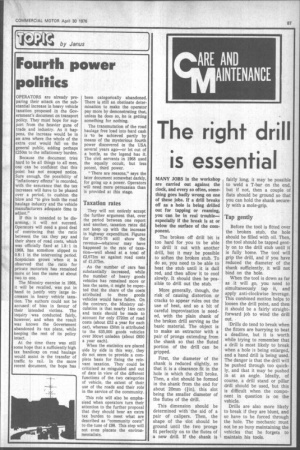The right drill is essential
Page 89

If you've noticed an error in this article please click here to report it so we can fix it.
MANY JOBS in the workshop are carried out against the 2lock, and every so often, something goes badly wrong on one of these jobs. If a drill breaks off as a hole is being drilled out for tapping or reaming, you can be in real trouble— especially if the break is at or below the surface of the component.
The broken off drill bit is too hard for you to be able to drill it out with another drill, but it may be possible to soften the broken stub. To do so, you need to be able to heat the stub until it is dull red, and then allow it to cool slowly. It should then be possible to drill out the stub.
More generally, though, the risk of causing distortion or cracks to appear rules out the use of heat, and so a bit of careful improvisation is needed, with the plain shank of the broken drill serving as the basic material. The object is to make an extractor with a pair of prongs extending from the shank so that the fluted portion of the drill can be gripped.
First, the diameter of the shank is reduced slightly, so that it is a clearance fit in the hole in which the drill broke. Then, a slot should be formed in the shank from the end for about 20mm (tin), this slot being the smaller diameter of the flutes of the drill.
This dimension should be determined with the aid of a pair of calipers. Then, the shape of the slot should be ground until the two prongs fit perfectly on to the flutes of a new drill. If the shank is fairly long, it may be possible to weld a T-bar on the end, but if not, then a couple of flats should be ground so that you can hold the shank securely with a mole-grip.
Tap gently
Before the tool is fitted over the broken stub, the hole should be filled with oil. Then, the tool should be tapped gently on to the drill stub until it is fully home. The tool will grip the drill, and if you have reduced the diameter of the shank sufficiently, it will not bind on the hole.
When the tool is down as far as it will go, you need to simultaneously tap it, and apply anti-clockwise leverage. This combined motion helps to loosen the drill point, and then it should be a fairly straightforward job to wind the drill out.
Drills do tend to break when the fitters are hurrying to beat a deadline, but it is worth while trying to remember that a drill is most likely to break when a hole is being enlarged, and a hand drill is being used. The danger is that the drill will be pushed through too quickly, and that it may be pushed in at an angle. Ideally, of course, a drill stand or pillar drill should be used, but this is difficult when the component in question is on the vehicle.
Drills are also more likely to break if they are blunt, and so have to be forced through the hole. The mechanic must not be so busy maintaining the vehicles that he forgets to maintain his tools.
















































































































































